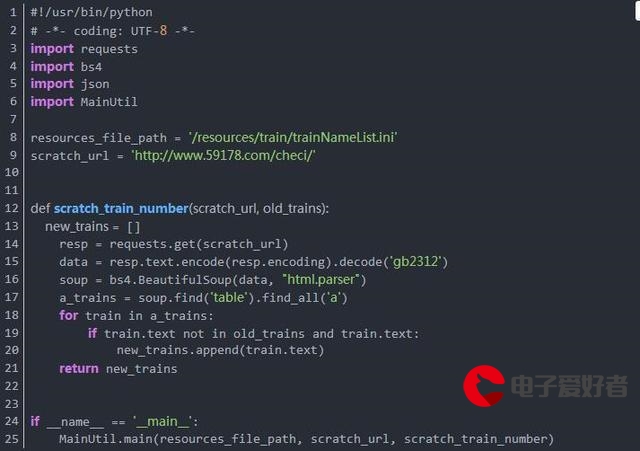 cheetah"/>
cheetah"/>
cheetah
Cheetah-Software 程序分析之 ./common/FootStepPlanner
- 前言
- CMakeLists.txt
- GraphSearch.h
- GraphSearch.cpp
- 总结
前言
由于目前没有找到对MIT Mini Cheetah源码的解读而多是介绍仿真步骤,因此我将逐步的对其进行分析,其中的不足之处和不理解之处请多多提出,以共同进步。
CMakeLists.txt
先上代码
include_directories("./")
include_directories("../../common/include/")
file(GLOB_RECURSE sources"./*.cpp")add_library(footstep_planner SHARED ${sources})
target_link_libraries(footstep_planner biomimetics)
代码很简单,就是包含当前目录和上层 的include目录,生成一个名为footstep_planner的动态链接库。
GraphSearch.h
该程序模块的主要作用是构建每个time step的质心状态轨迹,包括机器人在该时间的位置,速度和转角。对于footstepplanner的程序来说,我觉得它应该还有使用论文中 1 提出的落足点选择的功能,但是找遍了全部的程序,依然看不见这几个公式的出现。。。。
接下来就一起看看程序是如何实现计算状态轨迹的:
/* 该部分是用来计算机体的轨迹 ,主要函数为buildInputTrajectory();*/#ifndef CHEETAH_SOFTWARE_GRAPHSEARCH_H
#define CHEETAH_SOFTWARE_GRAPHSEARCH_H#include <vector>
#include "cppTypes.h"//接触状态结构体
struct ContactState {union {bool contact[4];struct {bool fr, fl, rr, rl;};};ContactState(bool _fr, bool _fl, bool _rr, bool _rl) {fr = _fr;fl = _fl;rr = _rr;rl = _rl;}ContactState() { }
};//默认步态,trot,standing
struct DefaultGaits {std::vector<ContactState> trotting, standing;
};
//输入轨迹状态,应该是当前的基座状态,包含p,v,theta
struct InputTrajectoryState {Vec2<float> p;Vec2<float> v;float theta;
};//足底状态,位置p,接触状态contact,状态时间stateTime
struct FootplanFootState {Vec2<float> p;bool contact;float stateTime;
};//整体状态,t应该是周期,基坐标位置pBase,四个足底状态feet[4]
struct FootplanState {float t;Vec2<float> pBase;FootplanFootState feet[4];
};//状态缓冲,nodesVisited,最大容量maxMenory
struct FootplanStats {u64 nodesVisited;u64 maxMemory;FootplanStats() {//两个参数归零reset();}void reset() {nodesVisited = 0;maxMemory = 0;}
};
//基座期望目标位置
struct FootplanGoal {Vec2<float> goalPos;
};using FootplanStateCost = float (*)(FootplanState&, FootplanGoal&);
using FootplanTransitionCost = float (*)(FootplanState&, FootplanState&, FootplanGoal&);namespace FootplanCosts {//计算当前基座位置到目标基座位置的距离float distanceToGoal(FootplanState& state, FootplanGoal& goal);
}// cheetah._bodyLength = 0.19 * 2;
// cheetah._bodyWidth = 0.049 * 2;class FootstepPlanner {
public:FootstepPlanner(bool verbose);void reset();//根据输入构造轨迹,输入步态周期duration,单位时间dt,输入轨迹状态x0,角速度omegavoid buildInputTrajectory(float duration, float dt, InputTrajectoryState x0, float omega);void planFixedEvenGait(std::vector<ContactState>& gait, float gait_period);std::vector<InputTrajectoryState>& getInitialTrajectory() {return _inputTrajectory;}void addCost(FootplanStateCost cost) {_stateCosts.push_back(cost);}void addCost(FootplanTransitionCost cost) {_transitionCosts.push_back(cost);}FootplanGoal& getGoal() {return _goal;}DefaultGaits defaults;
private:bool _verbose;FootplanStats _stats;FootplanGoal _goal;std::vector<FootplanStateCost> _stateCosts;std::vector<FootplanTransitionCost> _transitionCosts;std::vector<InputTrajectoryState> _inputTrajectory;
};#endif //CHEETAH_SOFTWARE_GRAPHSEARCH_H
可以看到,.h文件对必要的结构体做了定义,虽然有对足底状态的结构体定义,但是并没有对这部分数据的计算。
GraphSearch.cpp
.cpp文件最主要的就是buildInputTrajectory函数,该函数按照时间步去计算对应时间下的质心状态。
#include "GraphSearch.h"
#include "Math/orientation_tools.h"float FootplanCosts::distanceToGoal(FootplanState &state, FootplanGoal &goal) {Vec2<float> dp = state.pBase - goal.goalPos;return dp.norm();//向量范数,即距离
}FootstepPlanner::FootstepPlanner(bool verbose) : _verbose(verbose) {_stats.reset();defaults.trotting = {{true, false, false, true},{false, true, true, false}};defaults.standing = {{true, true, true, true}};
}void FootstepPlanner::reset() {_stats.reset();_stateCosts.clear();_transitionCosts.clear();
}void FootstepPlanner::buildInputTrajectory(float duration, float dt, InputTrajectoryState x0, float omega) {if(_verbose) {printf("Input trajectory with %d steps\n", (int)(duration / dt));}_inputTrajectory.clear();_inputTrajectory.reserve(duration / dt);Vec3<float> velocity(x0.v[0], x0.v[1], 0.f);Vec3<float> position(x0.p[0], x0.p[1], 0.f);float theta = x0.theta;float t = 0;for(uint32_t i = 0; i < (duration / dt); i++) {Vec3<float> vRot = ori::coordinateRotation(ori::CoordinateAxis::Z, theta).transpose() * velocity;_inputTrajectory.push_back({{position[0], position[1]}, {vRot[0], vRot[1]}, theta}); //给出周期内每个time step的轨迹信息position += vRot * dt;t += dt;theta += omega * dt;}
}void FootstepPlanner::planFixedEvenGait(std::vector<ContactState> &gait, float gait_period) {(void)gait;(void)gait_period;
}总结
FootStepPlanner部分主要功能就是计算质心的状态轨迹,按照相关论文中的描述,个人认为该部分是应该包括落足点的选择的。在仿真过程中可以看到的是通过手柄对机器人进行控制,其速度改变的同时似乎对应的步长变长了,说明整体的程序中是有这么一个落足点选择函数的,但是我没有找到,还望多多交流。
Highly Dynamic Quadruped Locomotion via Whole-Body Impulse Control and Model Predictive Control ↩︎
更多推荐
cheetah












发布评论